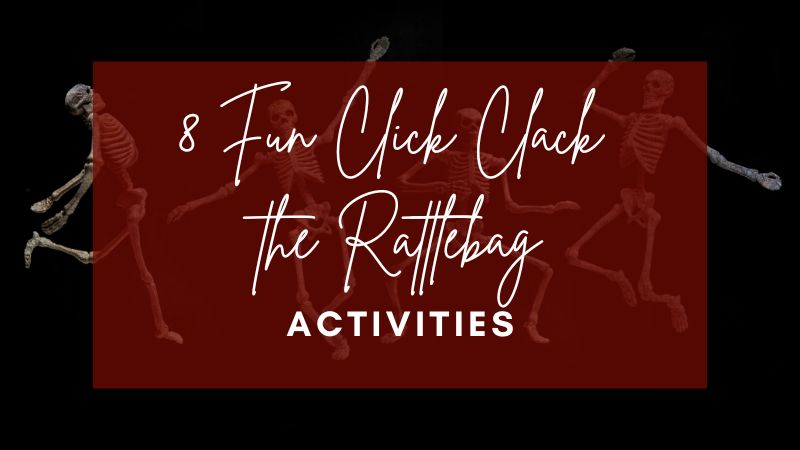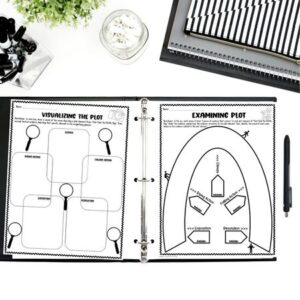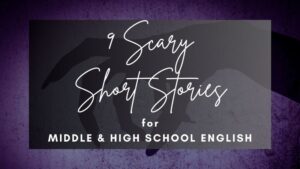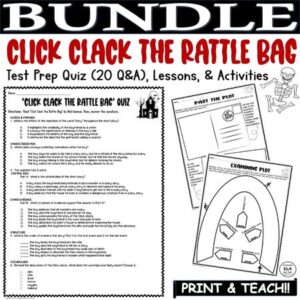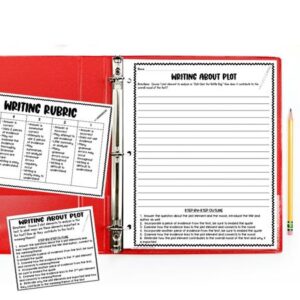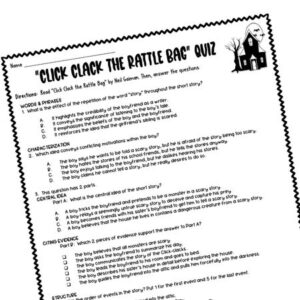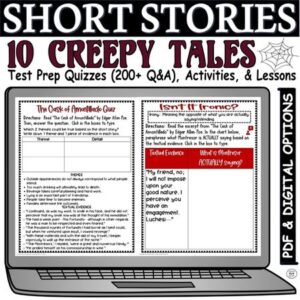While searching for short stories my students would love for Halloween, I stumbled upon Neil Gaiman’s “Click Clack the Rattlebag.” With great pleasure, I sat and read it within 10 minutes. And I was sold!
Sometimes, you find a short story that is simply fun and quite easy to read, and those short stories are so valuable in a secondary English classroom. We don’t need a million literary elements, symbolism, or a universal theme relevant for the next hundred years. Sometimes, a quick, short story without all of the pretense is the ticket for the day!
Keep reading for 8 Fun Click Clack the Rattlebag Activities that you can use in an upper-middle or lower-high school English classroom!
Need help with Test Prep? Check out this FREE Pack of 3 Test Prep Activities to help students achieve success on standardized tests!

8 Fun Click Clack the Rattlebag Activities
If you have never read the story Click Clack the Rattlebag, I encourage you to do so. It tells the tale of a teenage boy who watches his girlfriend’s little brother. During their walk to the young boy’s room to be put to bed, the boy tells the teen a tale of the Click Clacks.
I don’t want to spoil it for you, but the ending is both fun and frustrating at the same time!
1. Vocabulary Visuals
When it comes to reading short stories, authors are usually VERY intentional about the words they choose as most short stories are super short, especially compared to novels.
You can introduce the story by visualizing 5-10 words from the story before you start reading with your students. Even though “Click Clack the Rattlebag” is not especially difficult to read, some words may trip students up.
Here is a list to start with:
- intense
- precocious
- unimpressed
- ignorance
- draughty
- adjusted
- soberly
- unsettling
- threadbare
- corridor
- lair
- dissolved
- hygiene
- sagely
- scarce
- inherited
- amusement
- insufferable
- unrelentingly
Super engaging and effective!
2. Introduce Plot Elements, Mood, and Theme
Before you begin reading, you will want to focus on at least 1-3 standards for classroom instruction or a mini-lesson. I prefer to teach/reinforce plot elements, examine the mood and how it develops, and the theme(s) of the story!
PLOT ELEMENTS-main parts of the story
- Exposition-introduction to the setting, characters, and conflict
- Rising Action-events leading to the climax
- Climax-the highest point of interest in the story; the event that shifts the story
- Falling Action-events leading to the resolution
- Resolution-end of the story; when the conflict is resolved or dealt with in some way
MOOD- the reader’s emotional response or the overall atmosphere based on the setting, dialogue, events, and actions.
THEME-message(s) of the text; identify major topics and create a full sentence message for each topic -> the theme.
Check out these easy-to-use activities to help teach the plot elements of Click Clack the Rattlebag!
3. Practice Annotation
Read aloud with expression or find an audio recording online. There is one from the author.
After each paragraph, chunk, or page, stop and think aloud about the meaning of that part. Write your ideas down, modeling how to annotate for meaning with your students.
As you annotate, students should be annotating their own copies or they could take notes based on specific pieces of textual evidence.
You can focus on mood, plot elements, vocabulary, and theme, so students will be prepared for the activities and writing responses.
Need more Scary Short Story Ideas like Click Clack the Rattlebag? Click HERE!
4. Plot Analysis
After identifying the plot elements and locating textual evidence for each element, you can give your students a challenge and dig deeply more deeply!
See the first part of the chart below for help with guiding your students through this process!
| PLOT ELEMENT | EVENT | EVIDENCE | MEANING -> THEME |
| Exposition: How does the story introduce the characters, setting, and conflict? How are the characters portrayed? What is the effect? |
5. Postcard Activity
Because the end of the story is a bit ambiguous, you might encourage your students to finish or extend the story in some way.
Check out this Postcard Activity: Create a postcard from the young boy’s perspective based on a possible future plot or event linked to “Click Clack the Rattle Bag.” What might happen next?
- On the first side of the postcard, include a message, creative stamp visual, recipient, and address.
- On the second side of the postcard, draw a visual that represents a future plot or event.
As students are in creation mode with this assignment, they can think and respond more critically with this assignment!
6. Visualization
With scary stories, the description plays a major role. Focusing on imagery and creative language is vital for comprehension and analysis.
VISUALIZATION IDEAS:
- Character Picture
- Plot Element Depiction
- Comic Strip
- Movie Poster
- Film Reel
Ensure that students are using textual evidence from “Click Clack the Rattlebag” to support all of their visuals and justify their images by using effective rubrics!
7. Writing Ideas
When students write, they remember! There are so many ways to include writing when reading Click Clack the Rattlebag!
- Create questions for a Socratic Seminar or a student-crafted quiz.
- Examine how the mood changes from start to finish.
- Write a script for a play version of the story.
- Complete a literary analysis focused on characterization and theme.
- Write a paragraph or two to help end the story in a creative way.
- Create a review game for major ideas from the story.
- Use complete sentences to answer reading comprehension questions.
- Write a spooky narrative of your own.
While writing is not a student’s first go-to for entertainment, it is completely necessary if we want our students to grow!
8. Reading Comprehension Quiz
Even if you want to read Spooky Short Stories like “Click Clack the Rattlebag,” you can still prepare students for state standardized tests!
Here are 3 examples from this test prep quiz:
WORDS & PHRASES- What is the effect of the repetition of the word “story” throughout the short story?
MOOD/CITING EVIDENCE- This question has 2 parts. Part A: What is the mood at the beginning of the short story? Part B: Which 2 pieces of evidence support your answer to Part A?
CONFLICT- What are some conflicting motivations within the boy? Provide evidence.
If you want to make the process quick and easy, check out this readymade test prep quiz for Click Clack the Rattlebag!
SHORT STORY RESOURCES THAT INCLUDE CLICK CLACK THE RATTLEBAG ACTIVITIES
Need creepy short stories for upper middle and high school students? This 10 Scary Short Story Digital Resource BUNDLE includes lessons, test prep quizzes, and activities for texts like “The Most Dangerous Game,” “The Monkey’s Paw,” “The Tell-Tale Heart,” “The Veldt,” “The Lottery,” “The Masque of the Red Death,” “Click Clack the Rattle Bag,” “The Cask of Amontillado,” “Lamb to the Slaughter,” & “A Vendetta!”
Make teaching short stories with relevant and rigorous activities SIMPLE & EASY!
Need more resources like the Click Clack the Rattlebag activities above? Check out my store Kristin Menke-Integrated ELA Test Prep!

